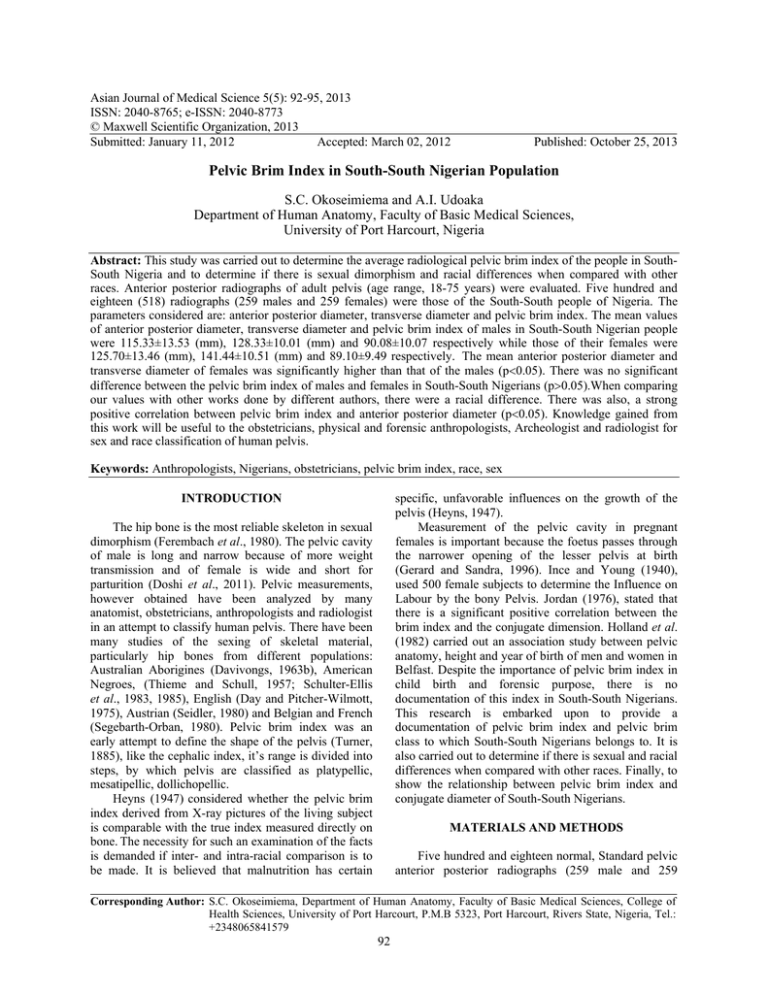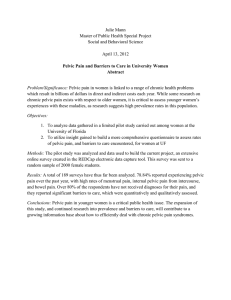
Asian Journal of Medical Science 5(5): 92-95, 2013
ISSN: 2040-8765; e-ISSN: 2040-8773
© Maxwell Scientific Organization, 2013
Submitted: January 11, 2012
Accepted: March 02, 2012
Published: October 25, 2013
Pelvic Brim Index in South-South Nigerian Population
S.C. Okoseimiema and A.I. Udoaka
Department of Human Anatomy, Faculty of Basic Medical Sciences,
University of Port Harcourt, Nigeria
Abstract: This study was carried out to determine the average radiological pelvic brim index of the people in SouthSouth Nigeria and to determine if there is sexual dimorphism and racial differences when compared with other
races. Anterior posterior radiographs of adult pelvis (age range, 18-75 years) were evaluated. Five hundred and
eighteen (518) radiographs (259 males and 259 females) were those of the South-South people of Nigeria. The
parameters considered are: anterior posterior diameter, transverse diameter and pelvic brim index. The mean values
of anterior posterior diameter, transverse diameter and pelvic brim index of males in South-South Nigerian people
were 115.33±13.53 (mm), 128.33±10.01 (mm) and 90.08±10.07 respectively while those of their females were
125.70±13.46 (mm), 141.44±10.51 (mm) and 89.10±9.49 respectively. The mean anterior posterior diameter and
transverse diameter of females was significantly higher than that of the males (p<0.05). There was no significant
difference between the pelvic brim index of males and females in South-South Nigerians (p>0.05).When comparing
our values with other works done by different authors, there were a racial difference. There was also, a strong
positive correlation between pelvic brim index and anterior posterior diameter (p<0.05). Knowledge gained from
this work will be useful to the obstetricians, physical and forensic anthropologists, Archeologist and radiologist for
sex and race classification of human pelvis.
Keywords: Anthropologists, Nigerians, obstetricians, pelvic brim index, race, sex
specific, unfavorable influences on the growth of the
pelvis (Heyns, 1947).
Measurement of the pelvic cavity in pregnant
females is important because the foetus passes through
the narrower opening of the lesser pelvis at birth
(Gerard and Sandra, 1996). Ince and Young (1940),
used 500 female subjects to determine the Influence on
Labour by the bony Pelvis. Jordan (1976), stated that
there is a significant positive correlation between the
brim index and the conjugate dimension. Holland et al.
(1982) carried out an association study between pelvic
anatomy, height and year of birth of men and women in
Belfast. Despite the importance of pelvic brim index in
child birth and forensic purpose, there is no
documentation of this index in South-South Nigerians.
This research is embarked upon to provide a
documentation of pelvic brim index and pelvic brim
class to which South-South Nigerians belongs to. It is
also carried out to determine if there is sexual and racial
differences when compared with other races. Finally, to
show the relationship between pelvic brim index and
conjugate diameter of South-South Nigerians.
INTRODUCTION
The hip bone is the most reliable skeleton in sexual
dimorphism (Ferembach et al., 1980). The pelvic cavity
of male is long and narrow because of more weight
transmission and of female is wide and short for
parturition (Doshi et al., 2011). Pelvic measurements,
however obtained have been analyzed by many
anatomist, obstetricians, anthropologists and radiologist
in an attempt to classify human pelvis. There have been
many studies of the sexing of skeletal material,
particularly hip bones from different populations:
Australian Aborigines (Davivongs, 1963b), American
Negroes, (Thieme and Schull, 1957; Schulter-Ellis
et al., 1983, 1985), English (Day and Pitcher-Wilmott,
1975), Austrian (Seidler, 1980) and Belgian and French
(Segebarth-Orban, 1980). Pelvic brim index was an
early attempt to define the shape of the pelvis (Turner,
1885), like the cephalic index, it’s range is divided into
steps, by which pelvis are classified as platypellic,
mesatipellic, dollichopellic.
Heyns (1947) considered whether the pelvic brim
index derived from X-ray pictures of the living subject
is comparable with the true index measured directly on
bone. The necessity for such an examination of the facts
is demanded if inter- and intra-racial comparison is to
be made. It is believed that malnutrition has certain
MATERIALS AND METHODS
Five hundred and eighteen normal, Standard pelvic
anterior posterior radiographs (259 male and 259
Corresponding Author: S.C. Okoseimiema, Department of Human Anatomy, Faculty of Basic Medical Sciences, College of
Health Sciences, University of Port Harcourt, P.M.B 5323, Port Harcourt, Rivers State, Nigeria, Tel.:
+2348065841579
92
Asian J. Med. Sci., 5(5): 92-95, 2013
Table 1. The mean anterior posterior diameter where
115.33±13.53 (mm) for males and 125.70±13.46 (mm)
for females. The anterior posterior diameter which was
described in Fig. 1 and 2 was sexually dimorphic. The
mean anterior posterior diameter of the females was
significantly higher than that of the males (p<0.05). The
mean transverse diameter were 128.33±10.01 (mm) for
males and 141.44±10.51 (mm) for females. The
transverse diameter which was described in Fig. 1 and 3
was also sexually dimorphic. The Mean transverse
diameter of the females was significantly higher than
that of the males (p<0.05). The pelvic brim index of
males and females were 90.08±10.07 and 89.10±9.49.
There was no significant difference in the pelvic brim
index between males and females (p>0.05).
The percentage classification of pelvic brim index
for South-South males and females is presented in
Fig. 4 and 5. It was observed in Fig. 4 that 55.98% of
South-South Nigerian males were platypellic, 28.96%
were dolichopelic and 15.06% were mesatipellic. It was
also observed in Fig. 5, that 51.35% of South-South
Nigerian females population were platypellic, 38.22%
were mesatipellic and 10.42 % were dolichopelic.
female) aged between 18 and 75 years were used from
their biometric data. This study was conducted in
South-South of Nigeria between March, 2011 to
November 2011. The following hospitals within SouthSouth Nigerian States were used: University of PortHarcourt Teaching Hospital, Rivers State, Braithwaite
memorial Specialist Hospital, Port Harcourt, Rivers
State; Federal Medical Centre, Yenagoa, Bayelsa State,
University of Benin Teaching Hospital, Ugbowo, Benin
city; Edo State and Rehoboth specialist hospital, DLine, Rivers State.
The routine distance from which these radiographs
were taken was 100 cm. All the radiographs were of
anteroposterior view. All the radiographs were free
from pathological changes and belonged to adults from
the ages of 18 to 75 years. In taking these
measurements the radiographs were placed on the
horizontal surface of an illuminator and the following
measurement were taken with the help of a vernier
calliper. A marker was used to mark these points for
clear visualization.
The measurements taken are the anterior posteror
diameter (AB); transverse diameter (FG).
The Anterioposterior diameter AB is a line
extending from the middle of the sacral promontary to
the pubic symphysis. The transverse diameter FG is a
line extending across the greatest width of the superior
aperture from the middle of the brim on one side to the
same point on the opposite side.
The radiological pelvic brim index was obtained as
follows:
Brim index = Anterior posterior diameter ×100
Transverse diameter
These parameters were obtained from the available
literature.
All linear measurements were in millimeters for
each parameter. The Data on the measured parameters
were analyzed using the z-test to determine the sex
differences and (p<0.05) was taken as being statistically
significant. The actual range for the male and female
sexes were found out. A pie chat was used for
percentage classification of the pelvic brim index for
males and females. A correlation study was also carried
out between the pelvic brim index and anterior posterior
diameter.
Fig. 1: Diagram showing anterior posterior diameter (AB)
and transverse diameter (FG) (Gray, 1918)
RESULTS
The result of the mean, standard deviation and
range of all radiographic measurements in the Pelvic
brim In South-South Nigerian population are shown in
Fig. 2: An anterior posterior radiograph showing anterior
posterior diameter of one of the subjects
Table 1: Showing mean, standard deviation and range of values in parameters measured in the pelvic brim
Parameter
N
Male mean±S.D.
Female mean±S.D.
p
Range for males
Anterior posterior diameter
259
115.33±13.53 (mm)
125.70±13.46 (mm)
p<0.05
78.96-151.00
Transverse diameter
259
128.33±10.01 (mm)
141.44±10.51 (mm)
p<0.05
90.09-155.00
Pelvic brim index
259
90.08±10.07
89.10±9.49
p>0.05
59.12-124.58
S.D.: Standard deviation; N: Sample size
93
Range for females
80.24-172.02
97.70-178.88
53.98-123.50
Asian J. Med. Sci., 5(5): 92-95, 2013
Table 2: Showing pelvic brim index classification of males in
different races or people
Authors
Dolichopelic Mesatipellic Platypellic
Turner (1885) Australians
Negros
British
Turner (1885) Bush men
Tasmanians
French
Turner (1885) Hottentots
New
Europians generally
caledonians
Turner (1885) Kaffirs
Mongolians generally
Turner (1885) Andamans
American Indians
Present study
South-South
Nigerians
The correlation between pelvic brim index and
anterior posterior diameter was shown in Fig. 6, where
both sex were combined. It was observed that there was
a positive correlation between the pelvic brim index and
the anterior posterior diameter (p<0.05).
Racial grouping of pelvic brim index of Males
were shown in Table 2. It was observed that there were
racial differences with respect to pelvic brim index.
Fig. 3: An anterior posterior radiograph showing transverse
diameter of one of the subjects
DISCUSSION
The Hip bone is an ideal bone for sex
determination because it not only reflects the general
differences between the two sexes but also the special
adaptation of female hip bone for child bearing. Turner
(1885) measured the brim index in Europeans, six
males and the mean transverse diameter was 127 mm
and a mean conjugate 98 mm, with a brim index 77;
and of eleven females with a mean transverse diameter
of 137 mm, and a mean conjugate diameter of 109 mm,
with a brim index 79. The mean brim index in three
female Sandwich Islanders was 83 (Turner, 1885).
Our result shows a racial difference. The mean
transverse diameter for South-South Nigerian males
was 128.33±10.01 (mm) which is higher than that of
the European males.
The value for our mean conjugate diameter for
males was 115.33±13.53 (mm) which is higher than
that of European males. The pelvic brim index of
Nigerian males was 90.08±10.07. This value is higher
than that of European males pelvic brim index. With
respect to the mean transverse diameter for females
recorded by Turner (1885). The value for our mean
transverse diameter was 141.44±10.51 (mm). This is
higher than that of European females transverse
diameter. Our conjugate diameter was 125.70±13.46
(mm), this is higher than that of European females
conjugate diameter. The mean pelvic brim index of
South-South Nigerian females was 89.10±9.49. This
value is higher than the recorded value for Europian
females and female Sandwich islanders.
From the research carried out by Turner (1885), he
stated that the males are dolichopellic in Australians
and Andaman Islanders, whilst the females are
mesatipellic. In the Bush race the males are
Fig. 4: A pie chart showing percentage classification of pelvic
brim index of males in South-South Nigerians
Fig. 5: A pie chart showing percentage classification of
pelvic brim index of females in South-South Nigerians
130
Pelvicbrim index
120
110
100
90
80
70
60
50
80
90 100 110 120 130 140 150 160 170
Anteroposterior diamter (mm)
Fig. 6: Showing correlation between pelvic brim index and
anterior posterior diameter in South-South Nigerians
Pelvic brim index: Anterior posterior diameter (mm);
r = 0.682; y = 34.0507 + 0.4619*x
94
Asian J. Med. Sci., 5(5): 92-95, 2013
REFERENCES
dolichopellic, the females platypellic (Turner, 1885). In
the Negroes and New Caledonians the males are
mesatipellic, the females are platypellic (Turner, 1885).
Amongst the Europeans generally with a platypellic
male index the females are still more platypellic
(Turner, 1885). In the South American Indians,
however, whilst the males are platypellic, the females
are on the verge of being mesatipellic. Our result is in
keeping with the result of Turner (1885) with respect to
the Negroes. The mean of South-South Nigerian males
was 90.08±10.07 which shows that they are
mesatipellic. The mean for South-South Nigerian
females was 89.10±9.49 which shows that they are
platypellic. In a Standardized radiological pelvimetry
conducted by Holland et al. (1982), it was observed that
out of the Seven indices of pelvic size and shape which
were measured from X-rays on each individual together
with social and biological factors including age, height
and year of birth, The Pelvic indices for men and
women of similar stature were significantly different,
with the exception of the Pelvic brim index. Our result
is in keeping with this as there was no significant
difference between the pelvic brim index of males and
females in South-South Nigerians. From our result it is
shown that the transverse diameter of the pelvic brim is
wider in females than that of the males.
In a research carried out by Jordan (1976), it was
observed that there was a strong positive correlation
between the pelvic brim index and anterior posterior
diameter. Our result is in keeping with this as there was
a strong positive correlation between the pelvic brim
index and anterior posterior diameter of South-South
Nigerians. It was observed that the conjugate diameter
was significantly higher for the higher brim index of
South-South Nigerians than for the lower brim index
group. This shows that brim index is a function of the
conjugate diameter rather than of the transverse
diameter.
Davivongs, V., 1963b. The femur of the Australian
aborigine. Am. J. Phys. Anthropol., 21: 457-468.
Day, M.H. and R.W. Pitcher-Wilmott, 1975. Sexual
differentiation in the innominate bone studied by
multivariate analysis. Ann.
Hum. Biol., 21:
143-151.
Doshi, B.D., H.G. Joshi and C.D. Mehta, 2011. The sex
determination by posterior border of adult human
hip bone. NJIRM, 2(2): 10-13.
Ferembach, D., I. Schwidetzky and M. Stloukal, 1980.
Recommendation for age and sex diagnoses of
skeleton. J. Hum. Evol., 9: 517-549.
Gerard, J.T. and R.G. Sandra, 1996. Principles of
Anatomy and Phyisiology.
8th Edn., Harers
Collins Publishers, pp: 168-213.
Gray, H., 1918. Anatomy of the Human Body. 1st Edn.,
University Press, London, pp: 662-674.
Heyns, O.S., 1947. The influence of X-ray
measurements on
the pelvic brim index. Brit.
J. Radiol., 20: 31-33.
Holland, E.L., G.W. Cran,
J.H.
Elwood,
J.H.M. Pinkerton and W. Thompson, 1982.
Associations between pelvic anatomy, height and
year of birth of men and women in Belfast. Ann.
Hum. Biol. J., 9(2): 113-120.
Ince, J.G.H. and M. Young, 1940. The bony pelvis and
its influence on labour: A radiological and clinical
study of 500 women. BJOG-Int. J. Obstet. Gy.,
47: 130-190.
Jordan, H.V., 1976. The determinants of pelvic brim
morphology in the female. S. Afr. Med. J., 50(20):
772-778.
Schulter-Ellis, F.P., D.J. Schmidt, L.A. Hayek and
J. Craig, 1983. Determination of sex with a
discriminant analysis of new pelvic bone
measurements: Part I. J. Forensic Sci., 28: 169-180.
Schulter-Ellis, F.P., LA. Hayek and O.J. Schmidt, 1985.
Determination of sex with a discriminant analysis
of new pelvic bone measurements: Part II.
J. Forensic Sci., 30: 178-185.
Segebarth-Orban, R., 1980. An evaluation of the sexual
dimorphism of the human innominate bone.
J. Hum. Evol., 9: 601-607.
Seidler, H., 1980. Sex-diagnosis of isolated Os coxae
by discriminant
functions. J. Hum. Evol., 9:
597-600.
Thieme, F.P. and W.J. Schull, 1957. Sex determination
from the skeleton. J. Hum. Biol., 29: 242-273.
Turner, W., 1885. The index of the pelvic brim as a
basis of
classification. J. Anat. Physiol., 20:
125-143.
CONCLUSION
This is the first research work carried out on pelvic
brim index on South-South Nigerians. Other works on
pelvic brim index should be carried out in other parts of
Nigeria. This work is therefore recommended to
obstetricians, physical and forensic anthropologists,
Archeologist and radiologist for sex and race
classification of human pelvis.
95





